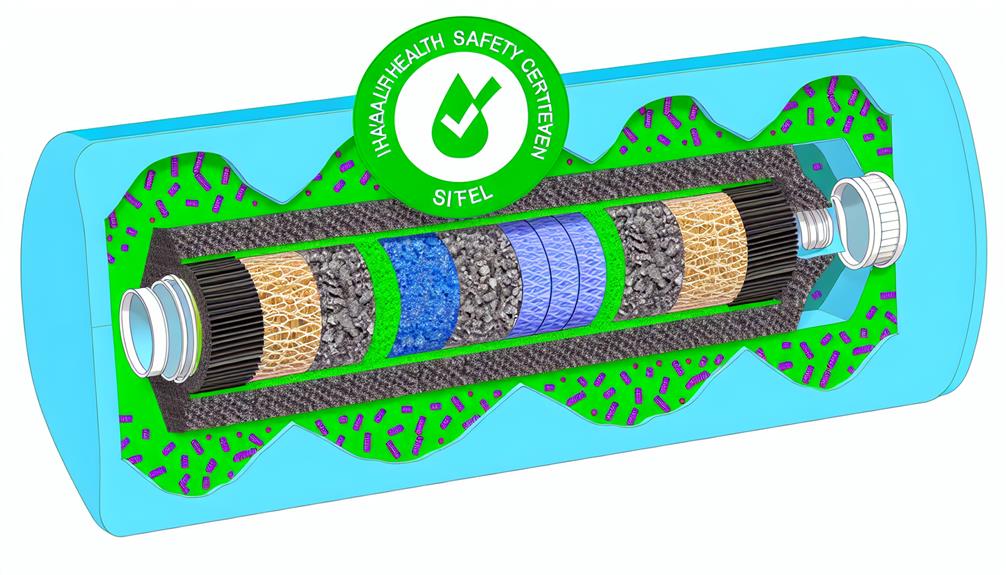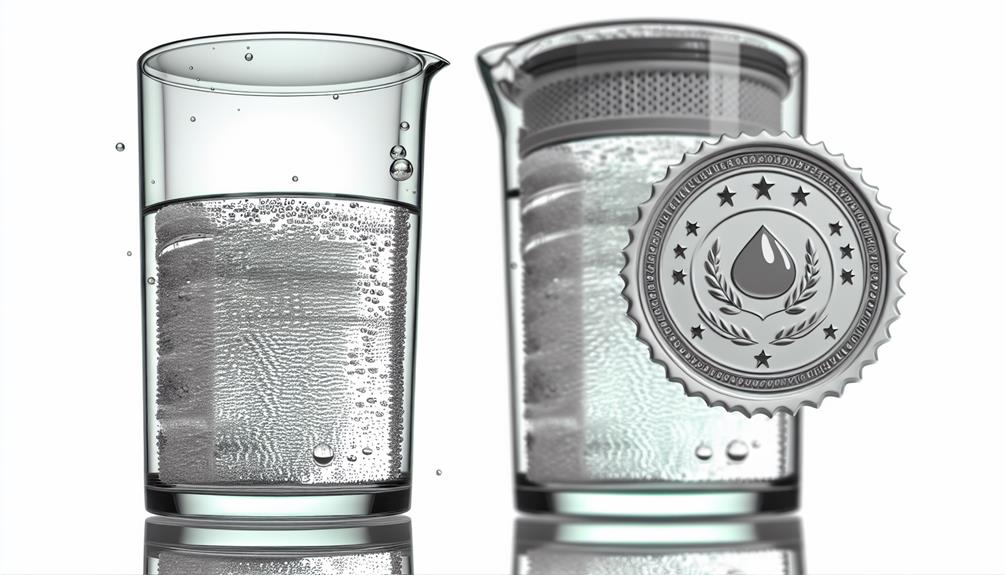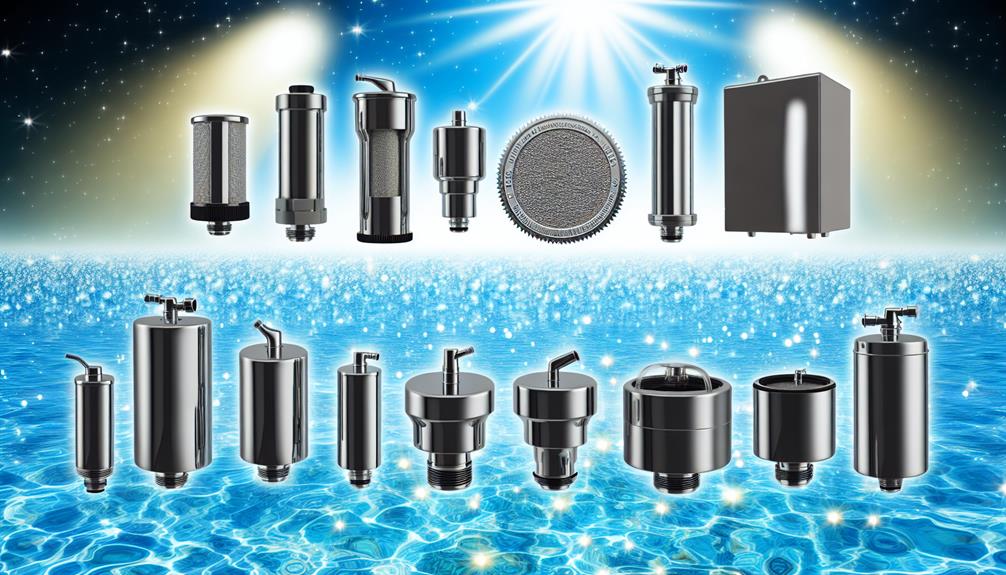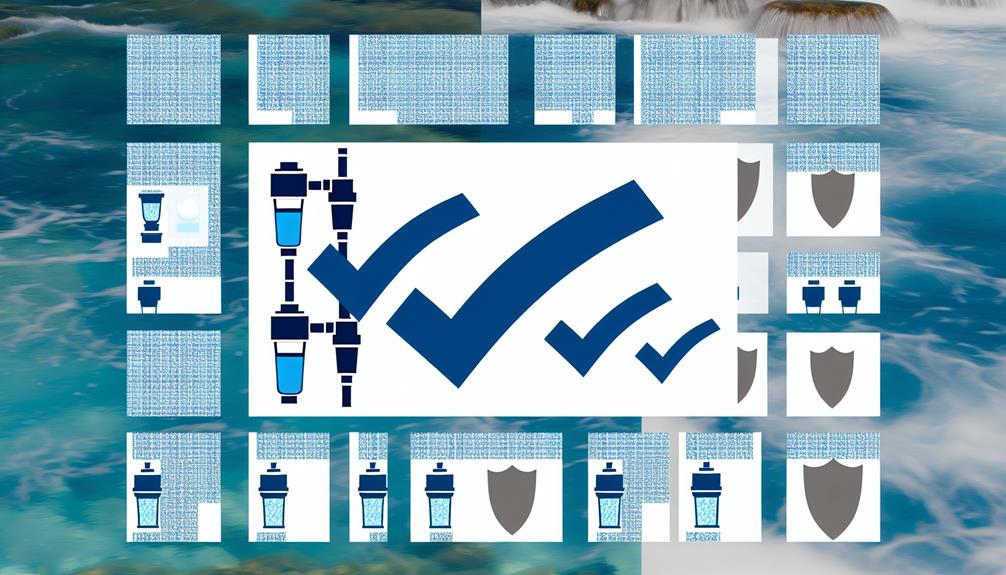Nearly 63 million Americans are exposed to unsafe drinking water each year, underscoring the critical role of effective water filters in safeguarding health. You might be considering a water filter for your home, given the rising concerns about contaminants ranging from lead to pharmaceuticals. With a multitude of options available, it's essential to choose a filter that meets rigorous health safety standards, ensuring that you and your family aren't just sipping clean water, but water that's been thoroughly vetted for safety.
As you weigh the merits of reverse osmosis systems against activated carbon filters, or contemplate the benefits of ultraviolet purification, remember that not all filters are created equal. Identifying which systems go beyond the basic removal of sediment and chlorine to deliver truly pure water involves understanding the nuances of certifications and technologies—a task that might seem daunting, but can significantly impact your well-being.
Join me in examining the top contenders in the water filtration market that not only promise clean water but are backed by the assurance of meeting health safety standards.
Understanding Health Safety Certifications

To ensure your water filter meets rigorous health safety standards, it's crucial to understand the certifications it carries. Certification bodies like NSF International or the Water Quality Association (WQA) set benchmarks for filter performance, material safety, and the structural integrity of water purification systems. These organizations rigorously test products to ensure they reduce specific contaminants as claimed by the manufacturer.
When you're assessing a filter's certification, you'll encounter terms like NSF/ANSI 53 for health effects or NSF/ANSI 42 for aesthetic effects, each addressing different concerns. The former relates to the reduction of contaminants with known health impacts, such as lead or mercury, while the latter pertains to non-health-related issues like chlorine taste and odor.
Moreover, it's vital to consider the filter lifespan, which reflects how long the filter can effectively remove contaminants before it requires replacement. Certified filters typically come with a manufacturer's recommended lifespan, but this can vary based on your water usage and the contaminant load. Overlooking this aspect may lead to a false sense of security, as an expired filter mightn't provide the protection it once did. Hence, you must regularly check and adhere to the recommended replacement schedules provided by the certification bodies.
Reverse Osmosis Systems Overview
When evaluating water purification options, reverse osmosis systems stand out due to their ability to remove a wide range of contaminants through a multi-stage filtration process. These systems typically include a prefilter to capture large particles, an activated carbon filter to remove chlorine and organic chemicals, and the reverse osmosis membrane, which is the core component. This semi-permeable membrane allows only water molecules to pass through, effectively reducing total dissolved solids (TDS) and eliminating pollutants such as lead, arsenic, and many microbiological threats.
Your focus on membrane maintenance is crucial for ensuring the longevity and efficiency of the system. Over time, the pores of the RO membrane can become clogged with contaminants. Regular monitoring and timely replacement are essential to maintain optimal TDS reduction and overall water quality. Adherence to the manufacturer's maintenance schedule, along with water quality tests, will alert you to when service or replacement is needed.
An analytical examination of reverse osmosis performance data reveals that systems with well-maintained membranes consistently achieve significant TDS reduction, often exceeding 95%. This level of purification aligns with rigorous health and safety standards, making reverse osmosis a reliable choice in your quest for contaminant-free drinking water.
Activated Carbon Filters Explained

Building on the discussion of reverse osmosis systems, it's essential to understand how activated carbon filters complement these setups by targeting chlorine, volatile organic compounds (VOCs), and other taste and odor-causing agents in water purification processes. Activated carbon filters are a pivotal component in achieving high-quality drinking water.
Here's a concise breakdown of their functionality:
- Adsorption: Activated carbon works through adsorption, trapping contaminants in the pores of the carbon substrate.
- Charcoal Sourcing: The carbon used is typically derived from coconut shells, coal, or wood; coconut shell carbon is renowned for its higher density and micro-porosity, which is ideal for water filtration.
- Chlorine and VOCs Removal: These filters are highly effective at removing chlorine and VOCs, which reverse osmosis systems can miss.
- Filter Lifespan: The lifespan of an activated carbon filter depends on the contaminant load and water usage, with many needing replacement every 6 to 12 months for optimal performance.
When selecting an activated carbon filter, consider the source of the charcoal and the projected filter lifespan to ensure you're getting a product that not only meets health safety standards but also offers effective long-term water purification.
Ultraviolet Purification Advantages
Ultraviolet purification systems offer a chemical-free method to eliminate pathogens in water, ensuring safe consumption without altering its taste or odor. When you opt for UV purification, you're choosing a system that excels in microbial inactivation. It works by exposing water to UV light at a germicidal wavelength, effectively deactivating the DNA of bacteria, viruses, and other pathogens, rendering them harmless.
This Chemical free treatment is a significant advantage, especially when considering the potential for harmful byproducts from other disinfection methods like chlorination. UV purification is a targeted approach, it doesn't introduce anything to the water nor does it create any byproducts.
Let's look at the technical specifics of UV purification advantages:
| Aspect | Benefit |
|---|---|
| Disinfection method | UV light (no chemicals) |
| Maintenance | Minimal; periodic bulb replacement |
| Energy use | Low, comparable to a light bulb |
| Effectiveness | Highly effective against all microorganisms |
| Taste and odor | Unchanged by the process |
Analytically, UV systems are efficient in terms of energy consumption and require low operational oversight. They're designed to be fail-safe, often incorporating alarms or indicators to alert you if the system isn't functioning properly. As you weigh your options, consider UV purification for its direct, potent approach to ensuring water safety.
Gravity-Based Filtration Effectiveness

You'll find that gravity-based filtration systems rely on the natural pull of gravity to draw water through a filter, effectively removing impurities without the need for electrical power. These systems are particularly noted for their microbial retention capabilities, which prevent bacteria and protozoa from contaminating your drinking water. Moreover, they're designed to preserve essential minerals, maintaining the water's natural balance and health benefits.
To understand the technical merits of these systems, consider the following:
- Multi-Stage Filtration: Gravity filters often incorporate several layers of media, each targeting specific contaminants. This stratified approach ensures comprehensive purification.
- Longevity and Maintenance: These units typically require less maintenance than other types. Their filters can last for months, or even years, depending on usage, before needing replacement.
- Microbial Retention: High-quality gravity filters can remove up to 99.9999% of pathogenic microorganisms, ensuring safe drinking water that meets stringent health safety standards.
- Mineral Preservation: Unlike reverse osmosis systems, gravity-based filters don't strip water of its beneficial minerals, which are crucial for maintaining the body's electrolyte balance.
Conclusion
In conclusion, you've explored the top-tier water filters that satisfy rigorous health safety standards.
Reverse osmosis systems strip contaminants, achieving near-pure results.
Activated carbon filters effectively adsorb organic compounds, while ultraviolet purification neutralizes pathogens without chemicals.
Gravity-based systems offer practical, energy-efficient filtration.
Through analytical scrutiny, these technologies demonstrate a commitment to health and safety, ensuring you access clean water.
Trust in evidence-backed solutions to safeguard your well-being.

